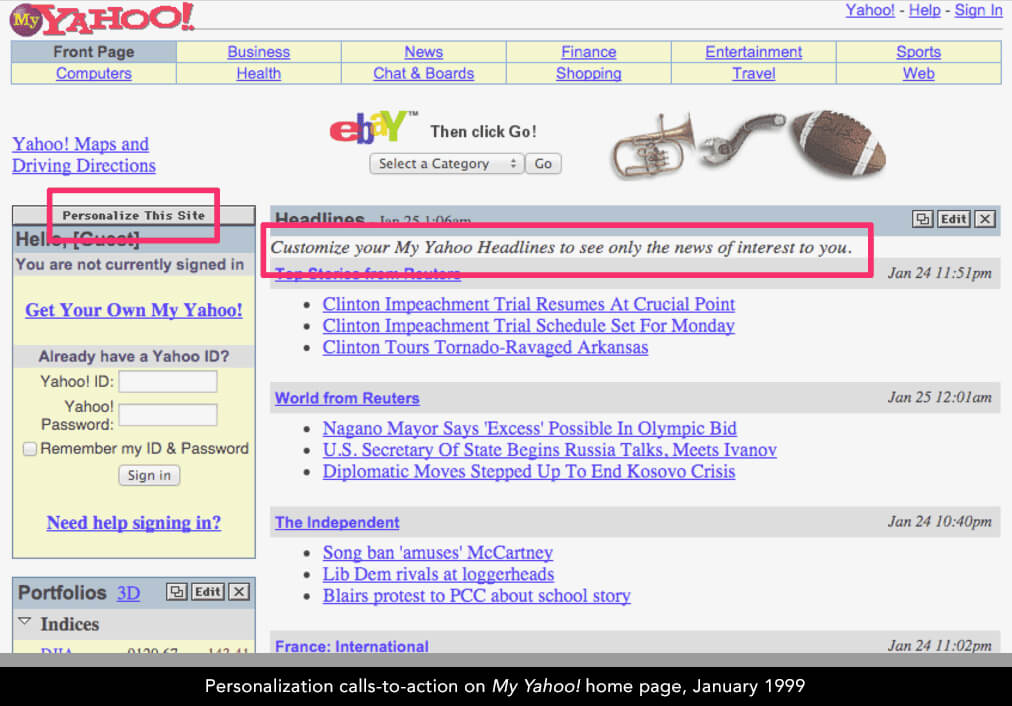An Introduction to Personalization
Companies that use data to deliver personalized user experiences see almost 50% higher revenue growth and 30% higher return on investment than those that don’t.1
From product recommendations to friend suggestions, users want intelligent solutions that seem to know them and can provide the right content, at the right time, tailored to the right device. But what exactly is personalization and how can you implement a personalization strategy that drives business results? Let’s start at the beginning.
What is Personalization?
Personalization refers to the process of tailoring an experience to the interests and needs of an individual. The idea is simple: by delivering the most relevant content to each user, you can dramatically improve the level of engagement, conversion and retention.
Personalization is a hot topic in the world of digital marketing today, though the use of personalization to enhance user experience is not a recent innovation. If we take a look back, we see that web personalization has actually been in practice for the last 20 years. As an example, consider My Yahoo! – the portal that launched back in 1997 – which enabled users to personalize listings of news and information to their interests and their region.

Fast forward to 2016. Personalization has become a must-have feature and almost every major commercial enterprise CMS platform comes with personalization functionality built-in. So, what's all the buzz about? To answer this question, let's define personalization more specifically in terms of digital strategy.
Real-time Personalization
Today, web personalization is often referred to as real-time personalization. Instead of having all visitors see the same thing, a personalization platform learns about each visitor as they interact with a company’s websites, apps, and other services. In this way, a profile of known and assumed attributes about a visitor is assembled and updated over time. Targeted content variations or personalized recommendations are then served to the visitor based on the data in their profile.
Marketers can target content to segments of users based on a variety of personalization criteria or visitor contexts, such as their current click path, details about past site downloads, their physical location, the type of device they’re using, or any preferences they’ve explicitly indicated. In this way, content can be personalized even for anonymous visitors or customers who are not signed in.
Personalization profile data can also be integrated with customer data that lives in other systems, such as a CRM like Salesforce, or a social platform like Facebook – making it possible to personalize digital experiences like never before.
“When you ask buyers what they want from their shopping experiences, they tell you they want to be recognized; they want to be valued; and they want to be known.”
– Penny Gillespie, Research Director, Gartner Inc.
Source: EContent Magazine
Most businesses serve many types of customers – each of whom have different needs or are at different steps in a buying process. Today, people use technology in a variety of contexts and across numerous devices. And consumer expectations have changed thanks to companies like Amazon, Netflix, and Spotify, who provide their customers with highly personalized experiences. So, why would anyone implement a strategy that involves serving the same content to everyone?
Common Personalization Challenges
A couple years ago, Adobe published the results of their Digital Marketing Optimization Survey. They found that 75% of all marketers believe that personalization is important to their organization’s long-term goals but that most still have a long way to go before they’ll be able to implement an effective personalization solution. This is not surprising given the variety of common challenges, such as:
- Cost prohibitive or limited resources
- Difficult to consistently produce quality content
- Lack of in-house digital marketing expertise
- Technical complexity or barriers with IT
- Performance or scaling challenges
- Privacy concerns with collection of visitor data
- Difficult to get buy-in from stakeholders across departments
Measurable Outcomes
To overcome common implementation challenges, it is important for organizations to start with small changes that can be easily measured. The use of data to drive results is critical.
With real-time personalization, you can deliver the most relevant content to a specific user at a specific time. In doing so, you reduce unwanted distractions and help to guide them towards a desired action, which could be a purchase, an account registration, a donation, an ad click, an information request, a newsletter sign-up, an app install, or a social engagement such as a Like or a Follow. We’ll refer to all of these broadly as conversions – the points at which a user completes a desired action. Conversion-oriented thinking is important for any personalization strategy because helps you to assess the effectiveness of your content in terms of measurable outcomes. Remember, personalization is essentially a process of optimization, and good optimization involves experimentation and making incremental changes that are informed by data.
What’s Next?
Effective digital marketing is about the intelligent use of technology to reach and convert leads into customers. In the coming blog series, I’ll describe the technology required to implement real-time personalization, and I’ll walk through the prerequisites to getting started with a personalization strategy. I’ll also review a number of personalization use cases for different industries including publishing, higher education, healthcare, and media/entertainment. You can also skip the series and go straight to my eBook, The Basics of Real-Time Personalization. It has all the content shared in the blog, and more.
While a lot of the information will apply to any digital platform, I'll focus on Drupal, and specifically Drupal 8, which I believe is the best CMS to build on for personalization. So, stay tuned to the FFW blog, or follow me on Twitter at @cmsdave for updates on new posts.
Attending DrupalCon New Orleans? Check out Dave’s session Web Personalization for Drupal Sites: Your Roadmap to Get Started.
1Source: Monetate
